|

|
TALA 10: [This is one of several pages published under this heading by LoughAllenBasin.com We endeavour to highlight what this area of NorthWest Ireland has to offer as a place to live, a place where interesting Plants and Animals may be found, and as a quiet peaceful location for Hi Tech Enterprise.]
BACK (to Index for this Section.) NEXT Topic (Irish Lady’s Tresses 2010) Lough Allen Basin HOME
loughallenbasin.com
|
|
|
10. Shoreline Flowers of Lough Allen (22nd. July)
beautiful flowers... rare plants... significant plants... diverse species
Lough Allen has a rich Biodiversity. This has not always been widely appreciated. It is now coming up to the ‘Orchid season’ and we will be busy monitoring their occurrence and success, if they emerge. (They don’t appear every year!) In the meantime here are some other members of Lough Allen’s flora, only one of them (the Blue-eyed Grass) significantly rare.
|
|
Location: All around Lough Allen’s shores.
Here is a collection of plants from the shores of Lough Allen, some very rare, some common; some small and insignificant, some small and very significant. Some included because they look very attractive; others because they are valuable and well distributed in the Lough Allen area... a further example of the great Biodiversity that exits in this small area.
|
|
 Corn Spurry Corn Spurry
This is an attractive member of the Pink Family which we associate with islands and neighbouring shores in several places around Lough Allen.
It is not rare but it is attractive and has an interesting and unusual structure. The place where we have found them has also been good for Creeping Jenny and Sneezewort, both travelling companions of our famous Orchid, Spiranthes romanzoffiana. Maybe this species can act as an early harbringer of the Orchid?It is described as an arable weed, not found on limey ground.
|
|
 Creeping Jenny Creeping Jenny
A brilliant splash of fluorescent green and bright yellow found among the grey rocks and colonising sandbanks among Alder carr at the top of beaches. Again often the same areas as the orchid, Irish Lady’s Tresses, likes.
It is related the Yellow Pimpernel found in fields and ditches and woodland edges. It is also a first cousin of the Yellow Loosestrife and related to the Primrose.
|
|
 The Pink Family is the family to which our garden Carnations and ‘Pinks’ belong (incl. Sweet William). It is a very diverse family including such species as Sea Campion with big bladders at the base of the flower, and Stitchwort. The Pink Family is the family to which our garden Carnations and ‘Pinks’ belong (incl. Sweet William). It is a very diverse family including such species as Sea Campion with big bladders at the base of the flower, and Stitchwort.
It is a low hairy annual (growing each year from seed) with greyish straight whorled leaves as opposed to the normal pattern of paired leaves leaving the main stem at swollen nodes (as in Carnations).
|
|
 It is widespread and abundant around Lough Allen, found everywhere apart from marshy or muddy shores. It sometimes forms a mat or a carpet over large areas of shingle or stony shorelines. It is widespread and abundant around Lough Allen, found everywhere apart from marshy or muddy shores. It sometimes forms a mat or a carpet over large areas of shingle or stony shorelines.
This is a great subject for your camera as it has very brilliant and numerous stark yellow flowers from mid-June to August. In dull weather this plant simply glows; in sunny weather it will easily burn out your photographs... so underexpose! It is also common and not at any risk so can be studied without harm. (NB. This cannot be said of all Lough Allen plants and many are subject to total protection and may not be picked or damaged.)
|
|
 Blue-eyed Grass Blue-eyed Grass
This is one of the rare ones of the pack! Only occurs as a naturally occuring plant in the west of Ireland. And we have it here in Leitrim! It occurs in good numbers at the north end of the lake.
Blue-eyed Grass is, actually, not a grass. But, when first seen it merges in with mid-height grasses very well and is nearly always found among them at the top of the shore and below where the typical Lough Allen shoreline of Alders and thorn bushes starts. It is quite sensitive to a position on the shore, not too low where it may be flooded for too long, nor too high where it may be overgrown by trees and bushes.
This is a plant that adores sunshine and this, and its preference for stony lake shores with good but not high vegetation, very much governs where it occurs. Look for it on west facing shores with a slight slope, well drained with many other plants growing among the stones and rough grassland, and look on a sunny day! This plant tracks the sun like a little blue Sunflower.
Conservation.
This species is not considered at risk in the Republic but is protected in Northern Ireland. The Botanic Gardens guidelines on general conservation issues would apply:
“The conservation of these plants must be achieved by protecting their habitats, since these plants do not occur in isolation, but as part of a living biological community. In conserving these habitats it is necessary to continue particular management strategies, often involving the maintenance of traditional farming practices. Outside these areas it is important to maintain features of the landscape that serve as refuges for wild plants, such as hedgerows, ponds and roadside verges.”
|
|
 Blue-eyed Grass is a member of the Iris family. The only other member of the family found in the British Isles is the Yellow Iris with its very big glamorous yellow flowers seen alongside water and in damp grasslands in early Summer. The Blue-eyed Grass has a simpler six petalled beautiful little soft blue flower with a striking yellow centre. On a sunny day in the right location, these blue flowers will pepper the long grass in a similar way to Forget-me-not, which also occurs alongside this species. Blue-eyed Grass is a member of the Iris family. The only other member of the family found in the British Isles is the Yellow Iris with its very big glamorous yellow flowers seen alongside water and in damp grasslands in early Summer. The Blue-eyed Grass has a simpler six petalled beautiful little soft blue flower with a striking yellow centre. On a sunny day in the right location, these blue flowers will pepper the long grass in a similar way to Forget-me-not, which also occurs alongside this species.
Flowers are produced from June to August, one at a time. The structure of the plant is similar to the Iris with a branching, very flattened body off which the flowering spikes are produced. Each flower only lasts for a day or two and then another flower is produced. That is why it is possible to see fresh flowers and well developed seeds side by side on the same plant.
 On a wet day the flowers close up and the blue stars are almost invisible. You can pass through a swathe of them and miss them unless you know they are there. On a wet day the flowers close up and the blue stars are almost invisible. You can pass through a swathe of them and miss them unless you know they are there.
It occurs in 11 Irish counties, frequent in Kerry and West Cork but more restricted in other western counties
|
|
|
|
 Habitat creating Plants! Habitat creating Plants!
We have been struck on our Trips around Lough Allen by the way certain plants, often very small and insignificant in themselves, can exploit a situation and rapidly burst into life creating a significant new habitat for other members of the plant and animal community.
On the right you see a forest of ‘grass’ on a bare shore that was shortly before covered in water. Yes, you are right; this is not a grass at all, but a flowering plant! This ‘lawn’ is made up of thousands of small flowering plants called Common Shore Weed. It is very much favoured by grazing sheep and presumably by other mammals and weed eating waterbirds. It is closely related to Mudwort, another of Lough Allen’s rare species. However, we regard this common species highly because of its significant impact on the environment. (Close-ups below.)
|
|
 Amphibious Plants! Amphibious Plants!
Lough Allen provides many variable habitats and environments for adaptable species. Some simply occupy new land as it dries out. Others are adapted to life both on water and land. The picture on the right shows a clump of Amphibious Bistort in its ‘water plant’ guise. This form has oblong floating leaves like a water lily and flowers prolifically.
Another version of the same plant can be found away from water, flowers less, and has long thin leaves. The water adapted plants seem to be fairly dependent on a reasonaby shallow depth of water for flowering. The location shown on the right has dropped a metre in depth since the start of the year. Equally we have seen water based Amphibious Bistort which has now dried out and is struggling to flower (below Right).
|
|
|
|

The three photographs, on the Left, show some details of the Common Shore Weed.
We must emphasise that these are very small plants and the details shown here are not visible to the naked eye (unless you are very young)! But that is why we have included them. Not rare, but significant and interesting.
|
|
 A young flower of Amphibious Bistort which has dried out and has been left with its floating leaves now stuck in the mud. This photograph was taken early in the season and the flower is not fully open. A young flower of Amphibious Bistort which has dried out and has been left with its floating leaves now stuck in the mud. This photograph was taken early in the season and the flower is not fully open.
The distribution of this plant is very patchy in Lough Allen. However, this is a species that can spread quickly and threaten to cover a small pond, so it may be more curtailed in larger bodies of water. It may only occur locally in Lough Allen simply because it needs the right sort of bottom to grow in and the right depth of water to flourish in.
The markedly fluctuating water levels of Lough Allen may be controlling the expansion of this species in a useful way. But this factor could also hinder other plants dependent on the shore water levels, i.e. Irish Lady’s Tresses?
Toad Rush
 A rapid coloniser of exposed mudflats. This is a branching Rush with a characteristic pattern of radial growth which makes it easy to recognise the young plants on bare shore. Also, it is often plucked by some animal unknown, but not eaten! Maybe it has an unpalatable taste? A rapid coloniser of exposed mudflats. This is a branching Rush with a characteristic pattern of radial growth which makes it easy to recognise the young plants on bare shore. Also, it is often plucked by some animal unknown, but not eaten! Maybe it has an unpalatable taste?
It is a common widespread rush of bare damp places. We include it here as it is one of the colonisers of large areas of bare mud that are exposed around Lough Allen, like the Shore Weed and Sneezewort. It could be a useful sort of food... if it only tasted nicer!
Sneezewort
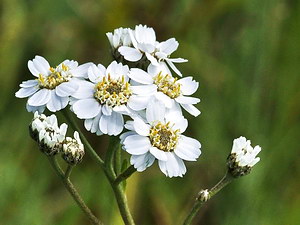 Fairly common around Lough Allen but also an indicator species. Some of our rarer plants are found in association with this plant. It is a member of the daisy family. The following interesting comments are taken from Wikipedia: Fairly common around Lough Allen but also an indicator species. Some of our rarer plants are found in association with this plant. It is a member of the daisy family. The following interesting comments are taken from Wikipedia:
Leaves can be eaten raw or cooked... The leaf is chewed to relieve toothache. The dried, powdered leaves are used as a sneezing powder. Yields an essential oil that is used medicinally. The leaves are used as an insect repellent. The plant is poisonous to cattle, sheep, and horses. Symptoms are generally slow to develop, and include fever, rapid pulse, difficulty breathing, weight loss, drooling, spasms and loss of muscular control, and convulsions.
|
|
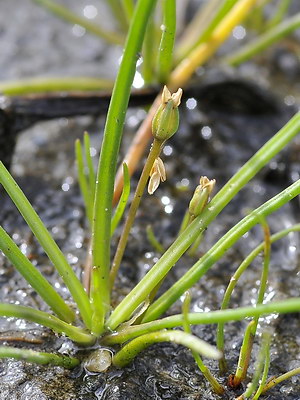
This picture shows the male flowers. Female flowers are produced at ground level as in its cousin the rarer Mudwort! The third photo in the series shows the very long anthers extending a huge distance out from the flowers. (Well actually about 5mm!)
|
|
Plant Diversity, Rarity, and Conservation in Lough Allen:
It’s all about Heritage! All Irish people are interested in some facet of Irish life, be it History, Music or Literature. Our Natural Heritage is also part of what makes this country unique. Many of the plant species listed on this page will not be widely known. Some are very small, almost insignificant. Some are prolific. But, they all have a role in our Lough Allen ecosystem.
|
|
 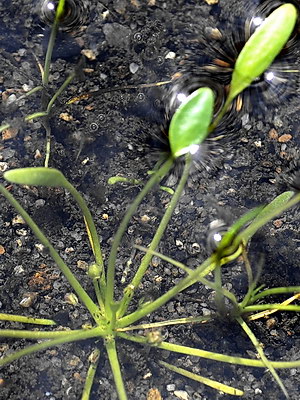 The two species shown (left and right) are first cousins, the Common Shore Weed and Mudwort. One is ‘common’; the other is very rare. One is significant and the other plays no clear role in the plant and animal community. Which, then, is more valuable? We would tend to adopt the view that any plant or groups of plants that tend to define an area are worth preserving. The Common Shore Weed is a source of fodder for cattle and sheep on the shoreline. However, it is under no risk of extinction. The two species shown (left and right) are first cousins, the Common Shore Weed and Mudwort. One is ‘common’; the other is very rare. One is significant and the other plays no clear role in the plant and animal community. Which, then, is more valuable? We would tend to adopt the view that any plant or groups of plants that tend to define an area are worth preserving. The Common Shore Weed is a source of fodder for cattle and sheep on the shoreline. However, it is under no risk of extinction.
One way of evaluating these plants is to consider how long they have been here. We don’t know, and there is some genetic research going on, but it may have been 10 or 20 thousand years. They probably were here before we were! It is amazing to think of a small living thing like Mudwort, hard to find and rarely seen because it’s often below water level, being around continuously for such a long period. Obviously, both these plants owe their existence to the presence of Lough Allen. What was Lough Allen like 20,000 years ago... being formed by glacial action, maybe?
There is much evidence of the effect of glacial action as a reason for Pollan and Irish Lady’s Tresses to be present, also Blue-eyed Grass. Maybe this is a factor in all our rare plants, akin to the Lusitanian factor (warm Atlantic water to our west)?
This photo (on the Right) shows the first of the Mudwort (we’ve seen) for this year. One plant on a shore of 100 metres that we actively scoured for others... without success! Most of this plant is underwater and the flowers (it is a flowering plant) can just be seen emerging at the base of the stalks.
|
|
|
|
|
|
 Guess what we found today! Guess what we found today!
Yes, this is the first of the Irish Lady’s Tresses we have seen so far this year. Ten plants have emerged on the northern shore of the Lake at a spot where one was seen last year and 21 the year before. These plants are only just up. They are above the water line and there may not be too much rain in the coming week. Ideal conditions for this very rare plant to grow and seed.
Further details of this plant and its significance can be found HERE. Further reports on its success and importance as a spectacular rare plant to Lough Allen will, hopefully be given in a subsequent article in our Trips around Lough Allen series.
It is great to see this plant flowering again in Lough Allen. It is a little bit late and last year it was almost totally washed out by un-seasonal flooding. Maybe this will be a Spiranthes spectacular year!
|
|
 This is the spiral flowering head of the Orchid, Spiranthes romanzoffiana, found in Lough Allen, some other lakes in north and west of Ireland and in parts of Scotland, mainly the Islands. It is not found anywhere else in Europe or Asia. This is the spiral flowering head of the Orchid, Spiranthes romanzoffiana, found in Lough Allen, some other lakes in north and west of Ireland and in parts of Scotland, mainly the Islands. It is not found anywhere else in Europe or Asia.
It is an exceedingly rare and precious plant. It can start off fairly insignificantly but, if conditions permit, it may become obvious to anyone out in the country. It is a plant protected in both the North and South of Ireland and any efforts that can be made to allow it to flower and set seed undisturbed would be a positive step in protecting our valuable biodiversity.
We would be very glad to hear of any further reports or photographs of this plant around Lough Allen (or, indeed, elsewhere) but do try and leave it undisturbed. (Contact us.)
|
|
|
|
|
|
The following is a brief collection of some other Lough Allen shoreline plants:
|
|
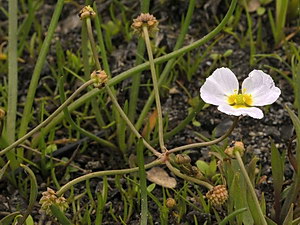
Lesser Water Plaintain (Baldellia ranunculoides)
|
|

Marsh Pennywort (Hydrocotyle vulgaris)
|
|
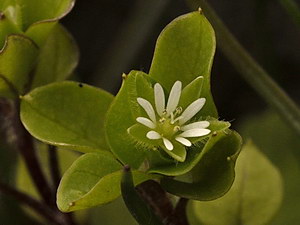
Common Chickweed (Stellaria media)
|
|

Flower of the Marsh Pennywort..
|
|

Sticky Mouse-ear (Cerastium glomeratum)
|
|

Water Purslane (Lythrum portula)
|
|
|
|
|
|
BACK to Section index.
NEXT Field Report
|
|
|
|
|
[MORE TRIPS to come! Including some from earlier dates than this one!]
If you have any interesting records of animals or plants from the Lough Allen basin, we will be very pleased to reproduce them here.
|